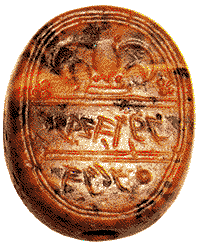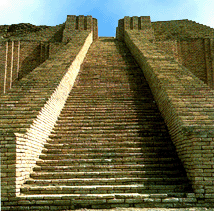Ancient Babylonia - Archaeology

- Gilgamesh Tablet
- The Hammurapi Stele
- Ancient Map
- Clay Model of a Sheep's Liver
- Mathematics Tablet
- Sheeps Liver Cuneiform
- Seal Impression
- Israelite Seal to Pedaiah
- Clay Cylinder of Nabopolassar
- The Striding Lion
- The Ishtar Gate
- The Dragon of Marduk
- Nebuchadnezzar's Babylon
- The Babylonian Chronicles
- Basalt Block Inscription
- The Ziggurats
- Nabonidus Stele
- Cyrus Cylinder

Babylonia
The modern recovery of the history of Babylonia began in the 19th century, following in the wake of the great archaeological discoveries in Assyria. Although initially the finds were not as spectacular as those in the northern region, the gradual exploration of Babylonia has awakened knowledge of its great civilization, which has developed throughout the 20th century.
Mounds
At the present time the area is filled with ruin-hills or mounds of accumulation of debris, which reveal the sites of ancient cities. Some of these cities were destroyed in a very early era, and were never rebuilt. Others were occupied for millenniums, and their history extends far into the Christian era. The antiquities generally found in the upper stratum of the mounds which were occupied up to so late a period, show that they were generally inhabited by the Jews, who lived there after the Babylonians had disappeared.
Excavations
There has been literally hundreds of thousands of inscriptions on clay and stone discovered on various sites in Iraq.
At Tello more than 60,000 tablets were found, belonging largely to the administrative archives of the temple of the 3 rd millennium BC.
At Nippur about 50,000 inscriptions were found, many of these also belonging to temple archives. But about 20,000 tablets and fragments found in that city came from the library of the school of the priests, which had been written in the 3 rd millennium BC.
At Sippar, fully 30,000 tablets were found, many being of the same general character, also representing a library.
At Delehem and Djokha, temple archives of the same period as those found at Tello have come to light in great numbers, through the illicit diggings of Arabs.
Babylon, Borsippa, Kish, Erech and many other cities have yielded to the explorer and the Arab diggers inscribed documents of every period of Babylonian history, and embracing almost every kind of literature, so that the museums and libraries of America and Europe have stored up unread inscriptions numbering hundreds of thousands. Many also are in the possession of private individuals.
The Ruins of Nebuchadnezzar's Babylon
Travelers and explorers have been drawn to Babylon for centuries, but serious archaeological research did not start until the mid 19th century. Much of the more recent work was carried out by German teams, but in the last few decades the task has been taken over by the Iraqi government. Almost everything that has been excavated relates to the great city built by Nebuchadnezzar II. The change in the course of the Euphrates River and a rise in the water table, along with the fact that king Nebuchadnezzar rebuilt the city so thoroughly, means that very little from before his time has been found or is likely to be.

Many inscriptions in cuneiform have been found, which describe the city. There is also an account by the Greek historian Herodotus, who visited the city of Babylon in about 460 BC. These make it possible to attempt a reconstruction of Babylon in the height of its glory.
There was a vast double wall on both sides of the Euphrates River with 8 gates, at least one of which, the Ishtar Gate, was faced with glazed bricks depicting bulls and dragons. From the Ishtar Gate ran the Processional Way - a wide paved road flanked by walls decorated with glazed and gilded bricks showing lions and dragons, which led to the Temple of Marduk and the adjacent Tower of Babel ziggurat which reached to 300 feet high.
There were 4 other temples, and west of the Ishtar Gate stood 2 palace complexes. The German archaeologist Robert Koldewey, who excavated the site from 1899 to 1917, found vaults in one of these palaces which he believed to be the foundations of the legendary Hanging Gardens.

The present site consists of several mounds which cover the remains of Nebuchadnezzar's summer palace, the Ishtar Gate and a further palace complex, the Temple of Marduk and the ziggurat, and a residential area. A reconstruction has been made of the Ishtar Gate, and other works are being carried out by the Iraqi government.
Read The Bible
- 1599 Geneva Bible (GNV)
- 21st Century King James Version (KJ21)
- American Standard Version (ASV)
- Amplified Bible (AMP)
- Amplified Bible, Classic Edition (AMPC)
- Authorized (King James) Version (AKJV)
- BRG Bible (BRG)
- Christian Standard Bible (CSB)
- Common English Bible (CEB)
- Complete Jewish Bible (CJB)
- Contemporary English Version (CEV)
- Darby Translation (DARBY)
- Disciples’ Literal New Testament (DLNT)
- Douay-Rheims 1899 American Edition (DRA)
- Easy-to-Read Version (ERV)
- English Standard Version (ESV)
- English Standard Version Anglicised (ESVUK)
- Evangelical Heritage Version (EHV)
- Expanded Bible (EXB)
- GOD’S WORD Translation (GW)
- Good News Translation (GNT)
- Holman Christian Standard Bible (HCSB)
- International Children’s Bible (ICB)
- International Standard Version (ISV)
- J.B. Phillips New Testament (PHILLIPS)
- Jubilee Bible 2000 (JUB)
- King James Version (KJV)
- Lexham English Bible (LEB)
- Living Bible (TLB)
- Modern English Version (MEV)
- Mounce Reverse Interlinear New Testament (MOUNCE)
- Names of God Bible (NOG)
- New American Bible (Revised Edition) (NABRE)
- New American Standard Bible (NASB)
- New American Standard Bible 1995 (NASB1995)
- New Catholic Bible (NCB)
- New Century Version (NCV)
- New English Translation (NET)
- New International Reader's Version (NIRV)
- New International Version - UK (NIVUK)
- New International Version (NIV)
- New King James Version (NKJV)
- New Life Version (NLV)
- New Living Translation (NLT)
- New Matthew Bible (NMB)
- New Revised Standard Version (NRSV)
- New Revised Standard Version Catholic Edition (NRSVCE)
- New Revised Standard Version, Anglicised (NRSVA)
- New Revised Standard Version, Anglicised Catholic Edition (NRSVACE)
- New Testament for Everyone (NTE)
- Orthodox Jewish Bible (OJB)
- Revised Geneva Translation (RGT)
- Revised Standard Version (RSV)
- Revised Standard Version Catholic Edition (RSVCE)
- The Message (MSG)
- The Voice (VOICE)
- Tree of Life Version (TLV)
- World English Bible (WEB)
- Worldwide English (New Testament) (WE)
- Wycliffe Bible (WYC)
- Young's Literal Translation (YLT)
Table of Contents
Main Menu
- Ancient Assyrian Social Structure
- Ancient Babylonia
- Ancient Canaan During the Time of Joshua
- Ancient History Timeline
- Ancient Oil Lamps
- Antonia Fortress
- Archaeology of Ancient Assyria
- Assyria and Bible Prophecy
- Augustus Caesar
- Background Bible Study
- Bible
- Biblical Geography
- Fallen Empires - Archaeological Discoveries and the Bible
- First Century Jerusalem
- Glossary of Latin Words
- Herod Agrippa I
- Herod Antipas
- Herod the Great
- Herod's Temple
- High Priest's in New Testament Times
- Jewish Literature in New Testament Times
- Library collection
- Map of David's Kingdom
- Map of the Divided Kingdom - Israel and Judah
- Map of the Ministry of Jesus
- Matthew Henry Bible Commentary
- Messianic Prophecy
- Nero Caesar Emperor
- Online Bible Maps
- Paul's First Missionary Journey
- Paul's Second Missionary Journey
- Paul's Third Missionary Journey
- Pontius Pilate
- Questions About the Ancient World
- Tabernacle of Ancient Israel
- Tax Collectors in New Testament Times
- The Babylonian Captivity
- The Black Obelisk of Shalmaneser
- The Books of the New Testament
- The Court of the Gentiles
- The Court of the Women in the Temple
- The Destruction of Israel
- The Fall of Judah with Map
- The History Of Rome
- The Incredible Bible
- The Jewish Calendar in Ancient Hebrew History
- The Life of Jesus in Chronological Order
- The Life of Jesus in Harmony
- The Names of God
- The New Testament
- The Old Testament
- The Passion of the Christ
- The Pharisees
- The Sacred Year of Israel in New Testament Times
- The Samaritans
- The Scribes
Ancient Questions
- Why Do the Huldah Gates Appear Different in Ancient Replicas and Modern Photos?
- What Is the Origin of the Japanese and Chinese Peoples? A Biblical Perspective
- How did the ancient Greeks and Romans practice medicine and treat illnesses?
- What were the major contributions of ancient Babylon to mathematics and astronomy?
- How did the ancient Persians create and administer their vast empire?
- What were the cultural and artistic achievements of ancient India, particularly during the Gupta Empire?
- How did ancient civilizations like the Incas and Aztecs build their remarkable cities and structures?
- What were the major trade routes and trading practices of the ancient world?
- What was the role of slavery in ancient societies like Rome and Greece?
- How did the ancient Mayans develop their sophisticated calendar system?
Bible Study Questions
- Why Do Christians Celebrate Christmas?
- How Many Chapters Are There in the Bible?
- The Five Key Visions in the New Testament
- The 400-Year Prophecy: Unpacking Genesis 15 and the Journey of a People
- The Authorized (King James) Version (AKJV): Historical Significance, Translation Methodology, and Lasting Impact
- Exploring the English Standard Version (ESV): Its Aspects, Comparisons, Impact on Biblical Studies, and Church Use
- A Detailed Historical Analysis of Language Updates in the KJ21: Comparison with Other Versions
- A Detailed Historical Analysis of the American Standard Version (ASV): Comparison to the King James Version, Influence on Later Translations, and Evaluation of Strengths and Weaknesses
- A Detailed Historical Analysis of Amplifications in the Amplified Bible (AMP) and Its Comparison to Other Bible Translations
- Detailed Historical Analysis of the Amplified Bible Classic Edition (AMPC): Examples of Amplifications and Comparative Analysis with Other Bible Translations
About
Welcome to Free Bible: Unearthing the Past, Illuminating the Present! Step into a world where ancient history and biblical narratives intertwine, inviting you to explore the rich tapestry of human civilization.
Discover the captivating stories of forgotten empires, delve into the customs and cultures of our ancestors, and witness the remarkable findings unearthed by dedicated archaeologists.
Immerse yourself in a treasure trove of knowledge, where the past comes alive and illuminates our understanding of the present.
Join us on this extraordinary journey through time, where curiosity is rewarded and ancient mysteries await your exploration.
Recent posts
-

How Philips Zoom Handpiece Limitations Impact Clinic Profitability — And How to Break the Cycle
For most dental and aesthetic clinics, professional whitening is expected to be one of the highest-margin services. Patients are willing to pay premiu... -

Do Scientists Believe in God? Faith and Science in the 21st Century
For centuries, people have debated whether science and faith can go hand in hand. Some argue that science should rely only on what can be measured and... -

Listening Deeper: Ekaterina Fakhrutdinova on How Soul Care Becomes a New Culture of Care
Author: Susan Perk Date: 24 Sep 2025 When faith is not dogma, but dialogue. And when psychology is not diagnosis, but service. Today, Christian psycho... -

The Vital Role of Christian Translation Ministries in Spreading the Gospel
The Gospel is for every tribe, tongue, and nation. Yet, millions of people around the world still cannot access Scripture in their own language. This ... -

The Vision of Clarity: Why Elegant Glasses Are the Perfect Choice for Modern Living
For centuries, vision has been associated not only with physical sight but also with wisdom, clarity, and perspective. In the modern world, where appe...